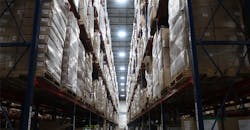Lighting Retrofit Revamps New Jersey Warehouse
Veeco Services, a full-service logistics provider, has a 615,000-sq ft warehouse in North Bergen, N.J. More than 14 football fields in size, the warehouse is equipped with 117 dock doors and 34,000+ pallet locations. The amount of space and the company’s commitment to efficiency make the company’s lighting and lighting controls critical to employee safety and profitability.
Although Veeco’s warehouse team was working efficiently, it became clear there were a variety of challenges with the warehouse lighting after a lighting audit was conducted in January 2019. The current high-intensity discharge (HID) fixtures were not only emitting poor lighting levels, but they were also wasting energy and were expensive to maintain. Additionally, Veeco had upgraded to a new racking system that added more rows and narrow aisles.
The old lighting included 366 HID and fluorescent lighting fixtures throughout the aisles that drew a 150,825W load. Based on the warehouses operating hours, the lighting was using 1,062,500kWh annually to deliver poor lighting levels. Overall, the warehouse lighting system was not working as safely and efficiently as it could.
National E Solution (NES), the company that performed the lighting audit, planned to redesign the lighting for the new aisles to improve foot-candles and the quality of lighting, while reducing the operating cost and maintenance. The lighting design was based on a detailed photometric study of the new aisles and loading dock area. To achieve optimal lighting levels, the company selected 168W high bay LEDs that produced 23,000 lm each with a color temperature of 5000°K. The new aisle lighting was created to achieve lighting levels that met the Illumination Engineering Society minimum standard for this work application. The customer’s target was an average of 25- to 30-ft candles. Enlighted’s wireless solutions and Internet of Things (IoT) technology were selected, as well. Each light was equipped with its unique address, allowing fixtures to be grouped.
Flexible lighting control was a huge benefit for Veeco. Its team was able to fine-tune the power output to the fixtures using the new control system. This allowed the company to reduce overall energy use and still achieve acceptable lighting levels. After a few trials, the team set the lighting system power load to 75% of the rated LED fixture load, which still provided excellent lighting for the warehouse crew. This reduced each fixture from a 168W load to 126W. Reducing the light output also extends the life of the LEDs and drivers far beyond the rated life on the specification sheet. Multiply the savings of 388 fixtures for 365 days and the systems begin to deliver real dollars saved.
“We can group the fixtures and control them beyond a traditional on/off occupancy sensor,” shares Orlando Ortiz, Veeco’s director of IT. “This allows for entire aisles to be lit only while in use for optimal savings and safety.” He adds that the system also has additional IoT features like facility mapping and asset tracking. While they aren’t currently using them, it provides future flexibility.
After one year in operation, Veeco reduced its lighting energy load by 59% by converting to LED fixtures, even though the fixture quantity increased. By controlling the lighting with a connected system, the facility achieved an 804,725kWh savings for the year that resulted in reducing energy costs by $122,318, a 75% total reduction in energy compared to the previous system. The new lighting and wireless control system reduced greenhouse gases and CO2 emissions by 554 metric tons, equivalent to removing 93 U.S. cars from the road annually. Additionally, the company will save an additional $14,000 per year on annual lighting maintenance since LED fixtures do not need to be maintained like the old HID fixtures.
In the event of a power failure, NES built a new emergency egress lighting plan into the system. This solution meets the National Electrical Code for egress lighting levels and allows employees enough time to access exits and evacuate safely. The installations also resulted in increased visibility for forklift drivers and other workers. An average of 2 to 7 foot-candles in the aisles were recorded before the project, and the results allow for up to 30 foot-candles based on fixtures at full power.
This LED installation not only improved safety in terms of visibility for the Veeco employees but also helped remove the fire risk caused by the old HID fixtures. The increased lighting level and 5000°K temperature helped to increase employee productivity and morale.
“We have increased the line of sight on the warehouse floor, which is critical to increasing efficiency and safety, and we have driven down energy costs significantly,” says Richard Lynch, president and chief operating officer of Veeco. “Installing a future proof and upgradable IoT system gives us a lot of room to grow and further enhance employee satisfaction, safety and operational efficiencies down the road. It’s been a huge win for us.”
